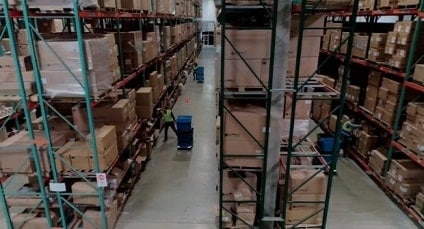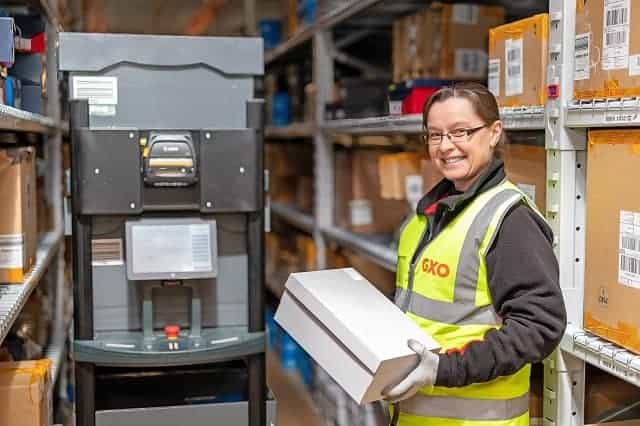Businesses are constantly on the lookout for ways to improve productivity, increase revenues, reduce cost and deliver better products/services to customers. One way to achieve all this is by optimizing warehouse operations. There are many best practices that can help you improve warehouse operations. In this post, we’ll take a look at a few key best practices that can help improve warehouse efficiency.
1. Carefully design your warehouse

A carefully planned warehouse layout is one of the foundations of efficient warehouse operations. While automation technology and robotics deliver great benefits, there’s no substitute for optimizing the organization of the physical space to enhance operational efficiency. In addition to minimizing travel time between picking/sorting stations, proper spacing allows for robots, machines and human associates to quickly and smoothly move inventory throughout the warehouse.
The best layout for your warehouse is one that’s designed to work with your systems and processes. It should be designed with several considerations in mind — such as your fulfillment strategy, picking system, type, size and frequency of orders and overall available space — to maximize every inch of floor space. Also, it’s a good idea to review your warehouse layout periodically to ensure it meets your current operational needs and standards.
2. Properly zone your inventory
Properly zoning your inventory is another effective way to increase warehouse productivity. The placement of your picking locations in relation to product storage, sorting, packing and shipping areas can make or break order fulfillment workflows. For instance, placing the most frequently picked items close to shipping areas can speed up fulfillment activities — resulting in faster shipping and more satisfied customers.
Place fast-moving items in easy-to-access storage locations and store items often purchased together in proximity. This reduces travel time during picking operations. However, you also need to consider the size, storage requirements and velocity of products to determine how best to store them.
3. Implement a streamlined returns process
With consumers returning at least 30% of all products purchased online, returns management has become an essential part of warehouse operations. The best way to handle this is by creating and implementing a returns process that is as efficient and process-oriented as your order fulfillment operation. Look for software solutions that have integrated returns processing capabilities.
Software solutions with integrated returns processing capabilities help to store and track all returns data, enabling you to see why an item was returned, who returned it, refunds due and any associated costs. Not only does this information help with inventory management, but it also enables you to understand your customers’ buying preferences and plan accordingly.
4. Leverage the right warehouse equipment & technology

Advancements in robotics technology and warehouse management systems continue to disrupt order fulfillment and distribution operations. There is a plethora of customized software, automation solutions, and smart robots to help businesses manage the storage, movement, sorting and shipping of warehouse inventory.
However, not all technologies are ideal for every warehouse operation. Aside from the significant installation, operating and maintenance costs of some warehouse automation equipment, they sometimes require a significant overhaul of existing warehouse infrastructure before they can be deployed. Your best bet is to choose a flexible, scalable and affordable solution that requires zero changes to your existing infrastructure.
Collaborative mobile robots offer flexible costs and are easy to scale. Deploying them boosts productivity and accuracy at the fraction of the cost of most automation solutions. For example, one leading 3PL doubled its pick rates, improved order accuracy to 99.9% and reduced new hire training time by 10 days after implementing Chuck by 6 River Systems.
5. Track your inventory
The accuracy of inventory records is one of the cornerstones of warehouse operations. Keeping a constant eye on inventory levels helps you avoid stockouts on fast-moving items or overstocking slow-moving items, which can increase long-term storage costs. Inventory tracking enables better inventory planning — you know when and how much of a product to reorder.
Every modern warehouse should include inventory management software in the lineup of warehouse solutions they use. These systems must work in real-time to provide an accurate record of all goods going in or coming out of the warehouse.
6. Automate data collection
Modern warehouses should use integrated solutions that support automated data collection and transfer. Tracking warehouse operations creates huge amounts of data — data that must be analyzed for logistics optimization. For instance, optimizing shipping operations in line with customers’ preferences requires the collation of data from multiple sources, including customers, orders, drivers, trucks and roads.
Manually collecting such data is tedious, time-consuming and prone to human error. Automating data collection helps to eliminate human error, speeds up processes and enables data analysis and more accurate supply chain insights. Armed with real-time data and accurate supply chain insights, companies achieve a higher percentage of on-time shipments to customers. The most successful retailers have an on-time delivery rate of 97% or greater.
Lastly, always have a backup plan. Identify worst-case scenarios and have contingency plans in place to enable business continuity despite setbacks.
With the growing impact of the Amazon effect and rising labor shortages, businesses must do all they can to maintain/increase their profit margins while keeping customers satisfied. Implementing these warehouse operations best practices will not only keep your bottom line healthy but also boost customer satisfaction.
Visit our case study to learn how one global home goods retailer increased pick rates by 62%, reduced errors and shortened new hire training time by leveraging Chuck and 6 River Systems.


